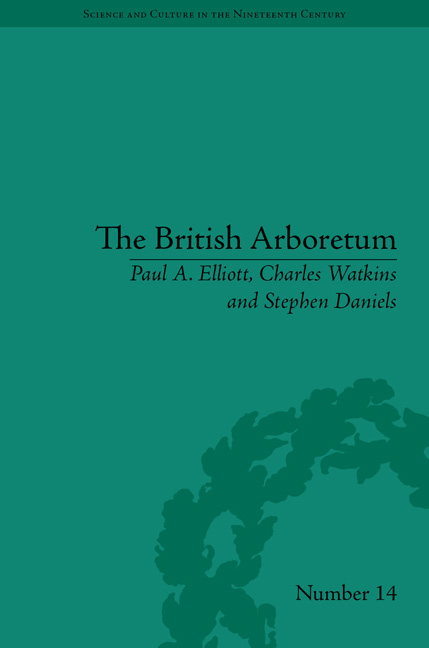Book contents
- Frontmatter
- CONTENTS
- List of Figures
- Preface
- Introduction
- 1 British Tree Cultures in the Nineteenth Century
- 2 Trees and Taxonomy
- 3 British Arboriculture, c. 1800–35
- 4 John Claudius Loudon's Arboretums
- 5 The Botany of the Arboretum Britannicum
- 6 The Derby Arboretum
- 7 Estate Arboretums
- 8 Public Urban Arboretums
- 9 The Transformation of Victorian Public Arboretums
- Conclusion
- Notes
- Works Cited
- Index
7 - Estate Arboretums
- Frontmatter
- CONTENTS
- List of Figures
- Preface
- Introduction
- 1 British Tree Cultures in the Nineteenth Century
- 2 Trees and Taxonomy
- 3 British Arboriculture, c. 1800–35
- 4 John Claudius Loudon's Arboretums
- 5 The Botany of the Arboretum Britannicum
- 6 The Derby Arboretum
- 7 Estate Arboretums
- 8 Public Urban Arboretums
- 9 The Transformation of Victorian Public Arboretums
- Conclusion
- Notes
- Works Cited
- Index
Summary
Introduction
Estate arboretums carried the impulse for tree collecting amongst the landed classes into the nineteenth century and were of considerable importance in the development of arboretums. The economic, botanical and iconographic significance of trees in British society, underscored by the prizes for planting awarded by the Society of Arts, encouraged landowners and their agents to undertake large-scale planting. Special kinds of tree collections or plantations were nurtured on many estates, usually associated with landscape gardens or their boundaries, although some came to occupy large areas or were spread along drives and rides. Estates also managed the remains of much older tree collections of great commercial, botanical or antiquarian interest, such as the sections of ancient Sherwood Forest lying within the Nottinghamshire Dukeries. Grand tree collections provided visible evidence of the magnificence, power, leisurely discernment and cultural pre-eminence of aristocracy and gentry – suggesting continuity and permanence just as their authority was beginning to erode. Frequently associated with the improvement, construction or reconstruction of houses, grand arboretums also provided an opportunity for the nouveau riche to assert their status and gain admittance to the landed classes. Larger estates had extensive resources and manpower, providing an important forum where landscape gardeners, gardeners and woodsmen could train and conduct experiments. Some gardeners and landscape gardeners such as Joseph Paxton, William Barron and William Coleman were launched into professional pre-eminence by great estates and aristocratic encouragement, their success enhancing their patron's reputation.
- Type
- Chapter
- Information
- The British ArboretumTrees, Science and Culture in the Nineteenth Century, pp. 155 - 184Publisher: Pickering & ChattoFirst published in: 2014



